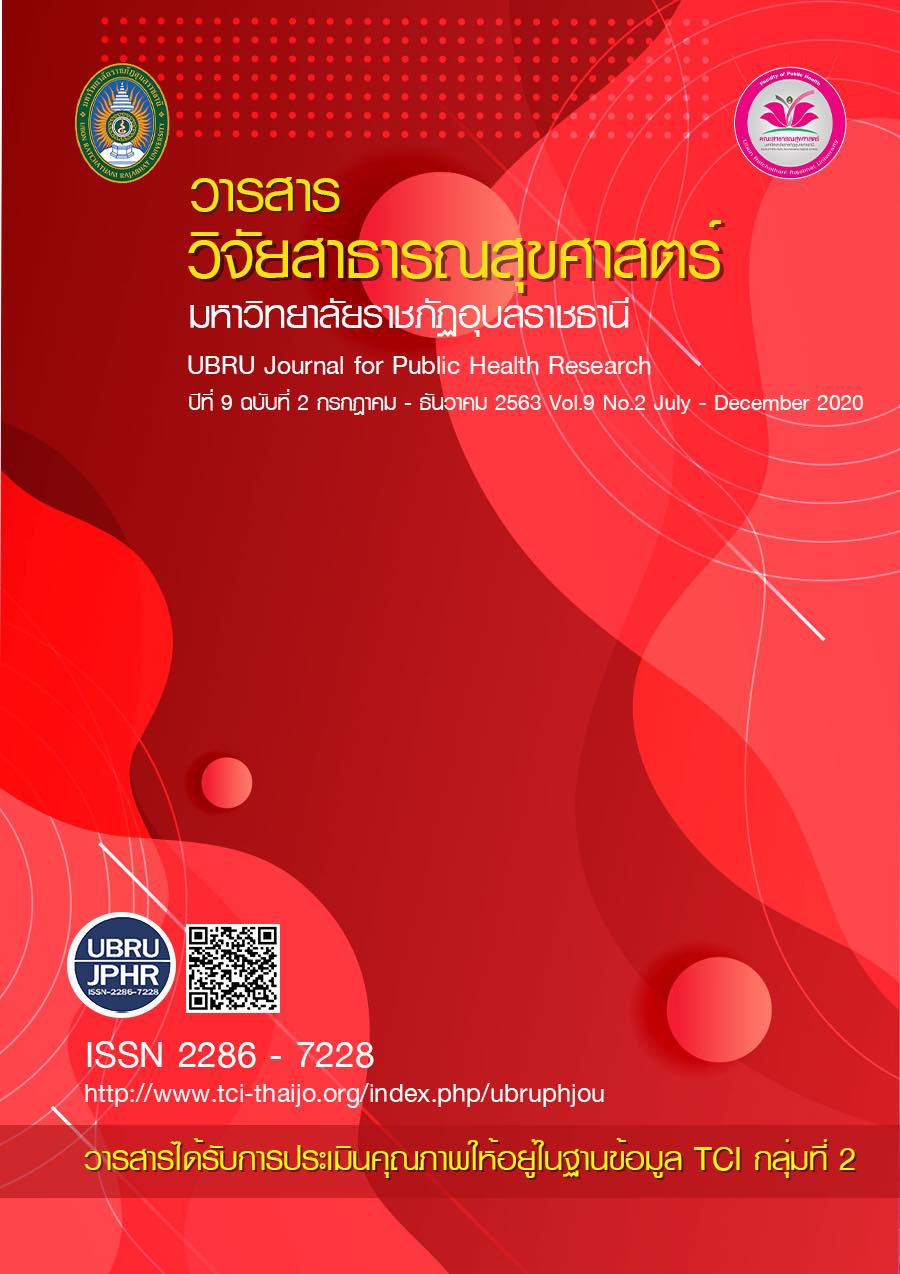Pharmaceutical care system for acute upper respiratory tract infection and acute bronchitis patient care to promote rational use of antibiotic in Nachaluai hospital, Nachaluai District, Ubonratchathani Province
Keywords:
Pharmaceutical care, upper respiratory tract infection, antibioticAbstract
This action aimed to explore a pharmaceutical care model for rational antibiotic use in upper respiratory tract infections and acute bronchitis patients in Na Chaluai Hospital, Ubon Ratchathani province. The 30 participants were included to participate in pharmaceutical care model development with 250 upper respiratory tract infection patients. The created quantitative questionnaire was used to data collection with expertise’s recommendation. Data were analyzed by using descriptive statistics and inferential statistics such Paired –sample t-test, Chi-square test. Qualitative data were collected by interviewing and observing with records and analyses by content analysis technique.
The results showed that the steps in this development consisted of 8 steps which were 1) study the context 2) the appointment of the working group 3) data collection and analysis 4) planning 5) implementation 6) Observing and monitoring 7) Evaluation and 8) the lessons learned. It was found that significantly in increasing in participation in persons involved in pharmaceutical care model. There was a significantly increasing knowledge and behavior of antibiotics usage and there was significantly increasing the average score of quality of life in upper respiratory tract infection patients.
In summary, Nachaluai Hospital has passed the antibiotic usage criteria for patients with upper respiratory infections. The key success factors comprised of announcing the antibiotic use guideline, interactive monitoring system in antibiotic prescribing, encouraging knowledge of antibiotic usage in their patients and the use of alternative medicine as a treatment option.
References
กมลนัทธ์ ม่วงยิ้ม. (2557). ความตระหนักรู้เกี่ยวกับการใช้ยาอย่างสมเหตุผลในบุคคลากรทางการแพทย์. วารสารวิจัยระบบสาธารณสุข, 1–28. สืบค้นจาก https://kb.hsri.or.th/dspace/handle/11228/4695
กานนท์ อังคณาวิศัลย์ และคณะ (2555). ความรู้และความตระหนักเกี่ยวกับการใช้ยาปฏิชีวนะอย่างสมเหตุผลของนักศึกษาชั้นปีที่ 1 มหาวิทยาลัยมหิดล. วารสารวิจัยระบบสาธารณสุข. 6(3), 374–381.
จิรชัย มงคลชัยภักดิ์, จิรวัฒน์ รวมสุข และเอมอร ชัยประทีป. (2555). การศึกษาความรู้และพฤติกรรมเกี่ยวกับการใช้ยาปฏิชีวนะของผู้รับบริการ ในร้านยาชุมชนจังหวัดปทุมธานี. วารสารวิชาการมหาวิทยาลัยอีสเทิร์นเอเชีย. 6(2), 91–100.
ดาวรุ่ง คำวงศ์ และ สังฆวัตร์ ทิวทัศน์. (2555). ปัจจัยที่มีผลต่อพฤติกรรมการใช้ยาของอาสาสมัครประจำหมู่บ้าน. ไทยเภสัชศาสตร์และวิทยาการสุขภาพ. 7(3), 121-126.
พิสนธิ์ จงตระกูล. (2558). โรงพยาบาลส่งเสริมการใช้ยาอย่างสมเหตุผล:เส้นทางสู่การใช้ยาอย่างสมเหตุผล. วารสารเภสัชวิทยา. 37(1), 48–62.
ภาณุมาศ ภูมาศ และคณะ. (2555). ผลกระทบด้านสุขภาพและเศรษฐศาสตร์จากการติดเชื้อดื้อยาต้านจุลชีพในประเทศไทย. วารสารวิจัยระบบสาธารณสุข, 6(3), 352–360.
วิวรรธน์ อัครวิเชียร (2541). เภสัชกรรมคลินิกและบริบาลเภสัชกรรม. เภสัชกรรมคลินิก Clinical Pharmacy, วิวรรธน์ อัครวิเชียร, บรรณาธิการ. 2541, ขอนแก่นการพิมพ์: ขอนแก่น. หน้า 1- 19.
สมหญิง พุ่มทอง และคณะ. (2560). บทเรียนจากการขยายผลสู่ความยั่งยืนของโครงการส่งเสริมการใช้ยาปฏิชีวนะอย่างสมเหตุผล. วารสารวิจัยระบบสาธารณสุข, 4(11), 500–515.
สุวัฒน์ มหัตนิรันดร์กุล, วิระวรรณ ตันติพิวัฒนสกุล และวนิดา พุ่มไพศาลชัย. (2545). เครื่องชี้วัดคุณภาพชีวิตขององค์การอนามัยโลกชุดย่อ ฉบับภาษาไทย (WHOQOL – BREF – THAI). [online]. สืบค้นจาก https://www.dmh.go.th/test/download/files/whoqol.pdf
คณะอนุกรรมการส่งเสริมการใช้ยาสมเหตุผล. (2558). คู่มือการดำเนินงานโครงการ โรงพยาบาลส่งเสริมการใช้ยาอย่างสมเหตุผล. พิมพ์ครั้งที่ 1. โรงพิมพ์ชุมนุมสหกรณ์การเกษตรแห่งประเทศไทย.
นิธิมา สุ่มประดิษฐ์, กัญญดา อนุวงศ์ และพิสนธิ์ จงตระกูล (2553). ผลของโครงการใช้ยาปฏิชีวนะอย่างสมเหตุสมผล : การนำร่องที่จังหวัดสระบุรี. วารสารวิชาการสาธารณสุข, 19(6), 899–911.
ทิพวรรณ วงเวียน. (2557). ความรู้เกี่ยวกับการใช้ยาปฏิชีวนะในโรคติดเชื้อเฉียบพลันของระบบทางเดินหายใจส่วนบนของผู้ป่วยนอกที่เป็นโรคดังกล่าวในโรงพยาบาลสมเด็จพระบรมราชเทวี ณ ศรีราชา. วารสารเภสัชกรรมไทย. 6(2), 106–114.
ภาณุมาศ ภูมาศ และคณะ. (2555). ผลกระทบด้านสุขภาพและเศรษฐศาสตร์จากการติดเชื้อดื้อยาต้านจุลชีพในประเทศไทย. วารสารวิจัยระบบสาธารณสุข. 6(3), 352–360.
สุวัฒน์ ปริสุทธวุฒิพร และมัณฑนา เหมชะญาติ. (2557). ปัจจัยที่มีผลต่อพฤติกรรมการใช้ยาปฏิชีวนะของผู้รับบริการในโรงพยาบาลขลุง จังหวัดจันทบุรี. วารสารศูนย์การศึกษาแพทยศาสตร์คลินิกโรงพยาบาลพระปกเกล้า, 31(2), 114-127.
Best JW &Kahn JV. (2014). Research in education (10th edition). United States of America: Pearson Education Limited.
Boonyasiri, A., &Thamlikitkul, V. (2014).Effectiveness of multifaceted interventions on rational use of antibiotics for patients with upper respiratory tract infections and acute diarrhea. Journal of the Medical Association of Thailand, 97(3), 13-19.
Chanishvili, N., & Aminov, R. (2019). Bacteriophage therapy: Coping with the growing antibiotic resistance problem. Microbiology Australia. 40(1), 5–7.
Grijalva, C. G., Nuorti, J. P. &Griffin, R. (2009). Antibiotic prescriptions rates for acute respiratory tract infections in the United States ambulatory. The Journal of the American Medical Association, 302(7), 758–766.
Holloway, K. A., Rosella, L., &Henry, D. (2016). The Impact of WHO Essential Medicines Policies on Inappropriate Use of Antibiotics. PloS one, 11(3), [online]. Retrieved from https://doi.org/10.1371/journal.pone.0152020
Kemmis, S &McTaggart, R. (1988). The Action Research Planer (3rd ed.). Victoria : Deakin University.
Krejcie, R.V.,and Morgan D.W. (1970). Determining sample size for research activities. Psychological measurement. 30(3), 607-610. [online]. Retrieved from https://doi.org/10.1177/001316447003000308
O’Neill, J. (2016). Tackling drug-resistant infections globally: final report and recommendations the review on antimicrobial resistance chaired by Jim O’Neill. Retrieved from https://amr-review.org/sites/default/files/160518_Final%.pdf
Saengcharoen, W., Lerkiatbundit, S., &Kaewmang, K. (2012). Knowledge, attitudes, and behaviors regarding antibiotic use for upper respiratory tract infections: A survey of Thai students. Southeast Asian Journal of Tropical Medicine and Public Health, 43(5), 1233–1244.
Van Boeckel, T. P., Gandra, S., Ashok, A., Caudron, Q., Grenfell, B. T., Levin, S. A., & Laxminarayan, R. (2014). Global antibiotic consumption 2000 to 2010: An analysis of national pharmaceutical sales data. The Lancet Infectious Diseases, 14(8), 742–750.
World Health Organization. (2002). Promoting rational use of medicines: core components. WHO Policy Perspectives on Medicines, Retrieved from https://doi.org/10.1038/clpt.1991.76
World Health Organization. (2012). The Pursuit of Responsible Use of Medicines: Sharing and Learning from Country Experiences, Retrieved from https://www.who.int/medicines/publications/responsible_use/en/
You, J. H. S., Yau, B., Choi, K. C., Chau, C. T. S., Huang, Q. R., & Lee, S. S. (2008). Public knowledge, attitudes and behavior on antibiotic use: A telephone survey in Hong Kong. Infection, 36(2), 153–159
Downloads
Published
How to Cite
Issue
Section
License
Copyright (c) 2020 คณะสาธารณสุขศาสตร์ มหาวิทยาลัยราชภัฏอุบลราชธานี

This work is licensed under a Creative Commons Attribution-NonCommercial-NoDerivatives 4.0 International License.
เนื้อหาและข้อมูลในบทความที่ลงตีพิมพ์ในวารสารวารสารวิจัยสาธารณสุขศาสตร์ มหาวิทยาลัยราชภัฏอุบลราชธานี ถือเป็นข้อคิดเห็นและความรับผิดชอบของผู้เขียนบทความโดยตรงซึ่งกองบรรณาธิการวารสาร ไม่จำเป็นต้องเห็นด้วย หรือร่วมรับผิดชอบใดๆ
บทความ ข้อมูล เนื้อหา รูปภาพ ฯลฯ ที่ได้รับการตีพิมพ์ในวารสารนี้ ถือเป็นลิขสิทธิ์ของวารสารฯ หากบุคคลหรือหน่วยงานใดต้องการนำทั้งหมดหรือส่วนหนึ่งส่วนใดไปเผยแพร่ต่อหรือเพื่อกระทำการใดๆ จะต้องได้รับอนุญาตเป็นลายลักอักษรณ์จากบรรณาธิการวารสารนี้ก่อนเท่านั้น


